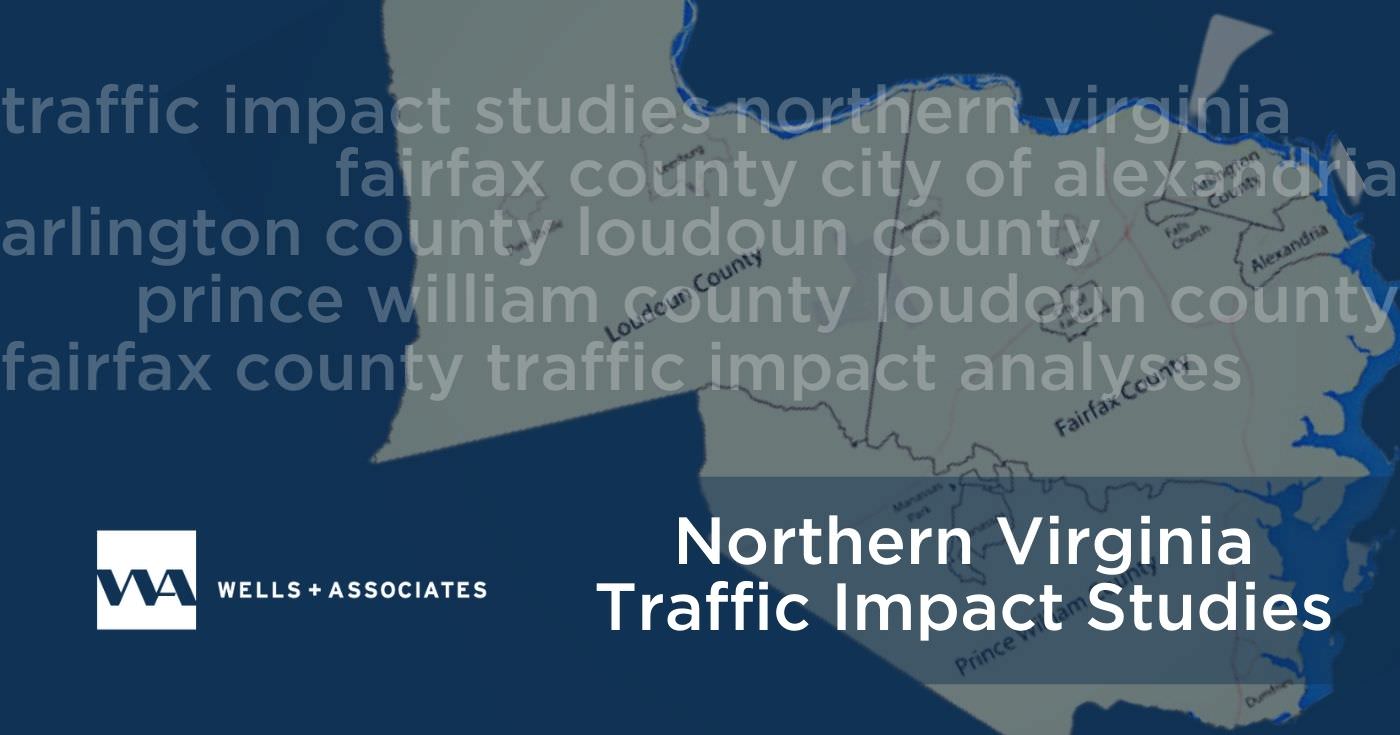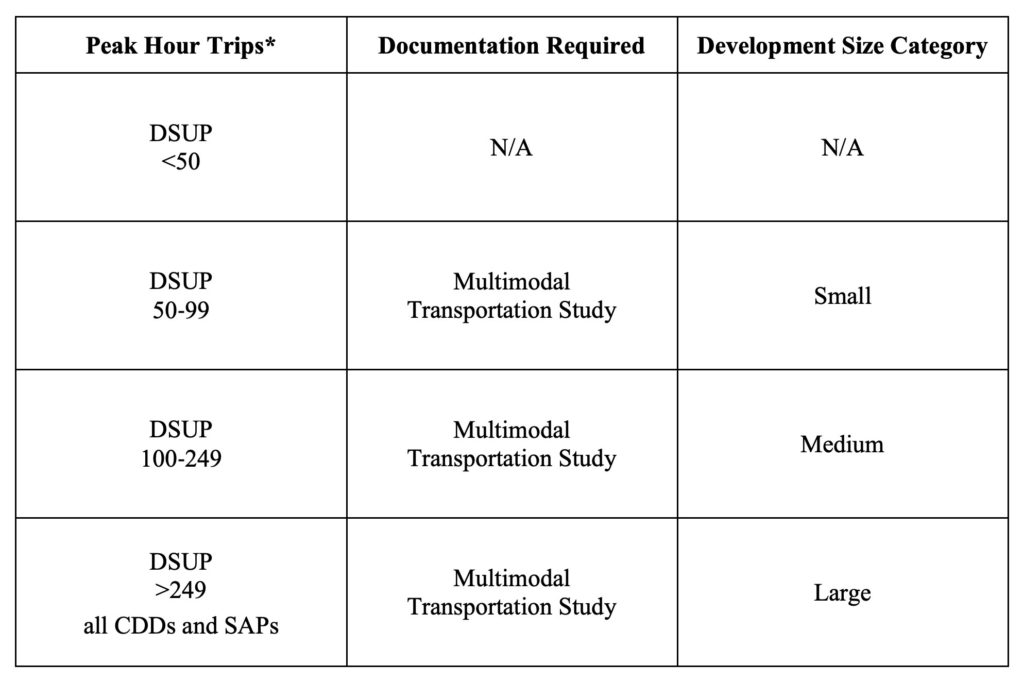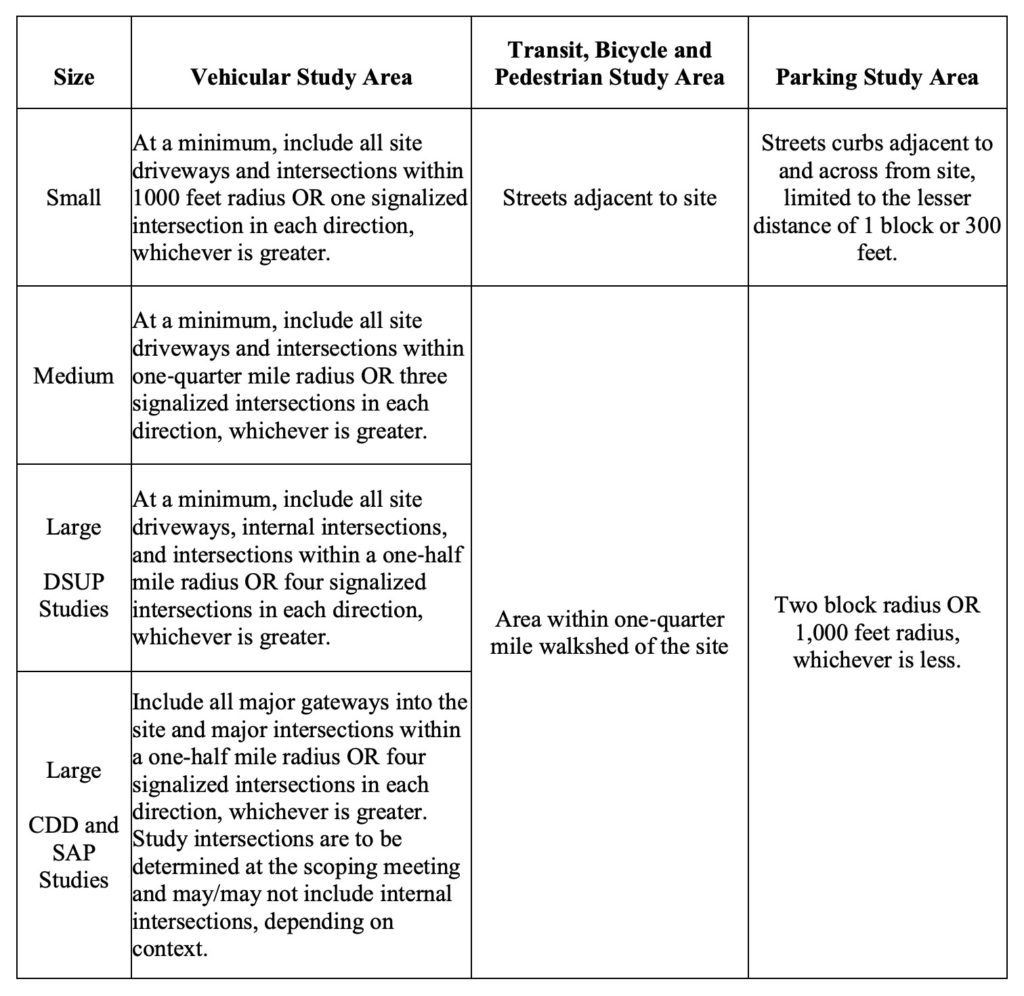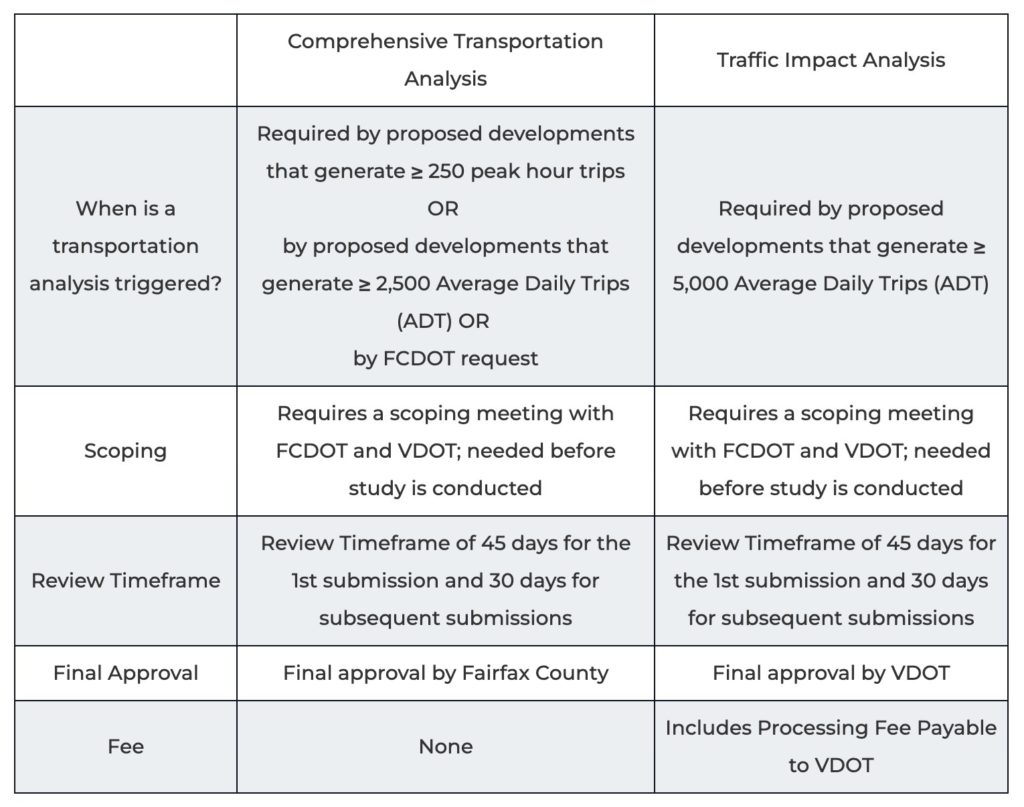Traffic impact studies (TIS) or traffic impact analyses (TIA) are prepared by traffic engineers in Northern Virginia to understand how a land development application impacts existing and future traffic conditions compared to the existing or by-right land use. The City of Alexandria, Arlington County, Fairfax County, Loudoun County, and Prince William County each implement unique processes to understand these impacts and determine if a development proposal would be required to implement traffic mitigation measures to offset the traffic impacts of the application.
What Developers Should Know About Traffic Impact Studies
Our team of Wells + Associates (W+A) traffic engineers, transportation planners, and Transportation Demand Management experts in Northern Virginia can attest that each development is unique. Depending on the specific mix of uses and the location of the site, each traffic study may be required to include different aspects of the transportation system by the reviewing agency.
These areas include:
- Intersection capacity analysis (levels of service)
- Vehicle queueing
- Pedestrian facilities
- Bicycle facilities
- Transit facilities
- Safety analyses
- Signal warrant studies
- Crosswalk warrant studies
- Access management
- Transportation demand management (TDM) measures
- Parking facilities and usage studies
Study areas and requirements may vary based on both W+A’s and the reviewing staff’s local knowledge and specific neighborhood or stakeholder concerns. These parameters are often proposed by the consultant and approved by the reviewing agency prior to completion of the study.
A TIS or TIA will typically assess the following scenarios:
Existing Conditions: Traffic operations as they exist today.
Future Conditions Without the Subject Development: Traffic operations as they will exist in the future without the subject development. This typically accounts for regional growth as well as other approved developments and road improvements in the vicinity of the site.
Future Conditions with the Subject Development: Traffic operations as they will exist in the future with the development’s traffic on the road network.
Based on these results, the TIS or TIA will typically recommend a series of mitigation strategies to help offset the impacts of the additional traffic generated by the proposed development. Physical mitigation strategies can vary in nature and may include:
- additional lanes for traffic
- new traffic signals
- modifications to and/or retiming of existing traffic signals
- enhanced pedestrian and bicycle infrastructure
Other mitigation strategies could include vehicle reduction strategies accomplished through Transportation Demand Management (TDM) plans. For example, Wells + Associates research in Fairfax County indicates that TDM has been highly effective at preventing negative traffic impacts.
Since 2012, Wells + Associates has been helping Fairfax County properties implement TDM programs and monitor their trip generation. Our review of performance metrics over a seven-year study period (2013-2019) for 13 properties is detailed in our original research article, Don’t Underestimate Your Property: Forecasting Trips and Managing Density Over the Long Term in Fairfax County, Virginia.
The following information details when a study is required in several of the Northern Virginia regulatory jurisdictions.
City of Alexandria Traffic Impact Studies
 The City of Alexandria’s Transportation Planning Administrative Guidelines determine when a Traffic Impact Study is required. Based on these guidelines, each project is scoped and coordinated with the Department of Transportation and Environmental Services (T&ES).
The City of Alexandria’s Transportation Planning Administrative Guidelines determine when a Traffic Impact Study is required. Based on these guidelines, each project is scoped and coordinated with the Department of Transportation and Environmental Services (T&ES).
The following peak hour trip thresholds detail the required study size to assess the site’s multimodal traffic impacts.
These trip thresholds are implemented without considering a non-auto trip reduction. The size of study determines the vehicular study area, transit, bicycle, and pedestrian study area, and parking study area as shown below:
Even if the site falls below the 50 peak hour trip threshold for a small study, a multimodal analysis may be required to support the application or for the site’s inclusion in the Residential Permit Program (RPP). A Screening Worksheet is required to be completed and submitted to T&ES for review and approval. This form includes trip generation estimates for the City of Alexandria to use to determine the appropriate study area, parking, and TDM measures required, consistent with the above guidelines.
Arlington County Multimodal Transportation Assessments
 Arlington County requires a Multimodal Transportation Assessment (MMTA) as part of the Administrative Regulations for 4.1 Site Plan applications. The MMTA is completed to support the County in their analysis of specific traffic or transportation impacts of the development proposal. Each MMTA is coordinated with staff from the Department of Environmental Services (DES) to identify the goals of the project.
Arlington County requires a Multimodal Transportation Assessment (MMTA) as part of the Administrative Regulations for 4.1 Site Plan applications. The MMTA is completed to support the County in their analysis of specific traffic or transportation impacts of the development proposal. Each MMTA is coordinated with staff from the Department of Environmental Services (DES) to identify the goals of the project.
Typically, the goals of the MMTA process include impacts on:
- Traffic
- Transit
- Pedestrian facilities
- Bicycle facilities
As the urban corridors and sector plans continue to develop in Arlington County, the transportation focus has improved to include multimodal facilities such as:
- Streetscape design
- Site frontage
- Local access for each travel mode
- Pedestrian facilities
- Bicycle facilities
- Parking supply and demand
- Electric vehicle parking
- Electric bicycle parking
Learn more about our traffic engineering services in Arlington here.
Fairfax County Traffic Impact Analyses
 Traffic Impact Analyses in Fairfax County are required under conditions such as rezoning, proffer condition amendments, special exception applications, and special permit applications. The analyses are to be submitted to the Fairfax County Department of Transportation (FCDOT) at the same time as applications are filed with the Fairfax County Department of Planning and Zoning (DPZ).
Traffic Impact Analyses in Fairfax County are required under conditions such as rezoning, proffer condition amendments, special exception applications, and special permit applications. The analyses are to be submitted to the Fairfax County Department of Transportation (FCDOT) at the same time as applications are filed with the Fairfax County Department of Planning and Zoning (DPZ).
The TIA is also sent to the Virginia Department of Transportation (VDOT) to be reviewed for compliance with regulatory submission requirements related to the state’s Traffic Impact Analysis Regulations. VDOT will then provide advisory comments to Fairfax County about the impacts on the transportation system and recommended improvements to lessen or negate the impacts of the development in question.
A VDOT Chapter 870 Traffic Study is required when a substantial impact is anticipated. A substantial impact is classified as a change that would allow the generation of 5,000 additional vehicle trips per day on state-controlled highways compared to the existing comprehensive plan assuming the highest density of permissible use in accordance with the Institute of Transportation Engineers (ITE) Trip Generation Manual.
If a VDOT Chapter 870 study is not required, Fairfax County will still review the application to determine if an Operational Analysis (OA) or Comprehensive Transportation Analysis (CTA) is required. The first steps and process for each FCDOT Transportation Analysis Option are detailed below:
As noted, a CTA may be required if the site exceeds 2,500 ADT or by FCDOT request. Effective June 16, 2022, FCDOT released a Phase 1 Comprehensive Analysis Checklist to emphasize pedestrian, bicycle, and transit modes, as well as to identify multimodal facilities for improvement during the development process. These items will be confirmed and detailed during the scoping process completed with FCDOT and VDOT staff.
Our team is also uniquely qualified to help during Fairfax County’s biannual Site-Specific Plan Amendment (SSPA) Process. We can accurately estimate vehicle trips for existing and proposed conditions that account for changes in density or program mix.
For a more detailed discussion of Fairfax County traffic engineer services and related needs, visit our Fairfax County Transportation Consultants page.
Loudoun County Traffic Impact Analyses
 Loudoun County, similar to Fairfax County, coordinates the traffic review process with VDOT. In accordance with the VDOT Traffic Impact Analysis Regulations, a VDOT Chapter 870 Traffic Study is required when a “substantial impact” is anticipated.
Loudoun County, similar to Fairfax County, coordinates the traffic review process with VDOT. In accordance with the VDOT Traffic Impact Analysis Regulations, a VDOT Chapter 870 Traffic Study is required when a “substantial impact” is anticipated.
A substantial impact is classified as a change that would allow the generation of 5,000 additional vehicle trips per day on state-controlled highways compared to the existing comprehensive plan assuming the highest density of permissible use in accordance with the Institute of Transportation Engineers (ITE) Trip Generation Manual. This process is confirmed in coordination and through collaboration with Loudoun County’s Department of Transportation and Capital Infrastructure in Loudoun County.
In addition to VDOT requirements, a Traffic Study Scoping Document is required to be submitted and coordinated with the Department of Transportation & Capital Infrastructure (DTCI). The requirements for a traffic study are outlined in the Loudoun County Facilities Standards Manual (FSM).
As part of the scoping process, a trip generation comparison of the proposed uses versus the existing uses is required. If the proposal maintains consistent trip generation or reduce the estimated trip generation for the site, additional study may not be required. For sites that are estimated to generate additional trips compared to existing uses, a capacity analysis is typically required for intersections where the development would account for 10 percent or more of the existing total traffic.
As of Fall 2022, Loudoun County has taken on the responsibility of collecting traffic data on behalf of Applications. The County generally requires six (6) weeks from the data request to provide the traffic data. The request would result as an outcome of the traffic study scoping meeting with DTCI staff.
Prince William County Traffic Impact Analyses
 As with Loudoun County and Fairfax County, the VDOT Chapter 870 Traffic Study process is followed in Prince William County for developments generating 5,000 or more vehicles trips per day. Below the VDOT Chapter 870 threshold, TIAs are generally required for all rezoning applications, special use permits, and site plans submissions in Prince William County.
As with Loudoun County and Fairfax County, the VDOT Chapter 870 Traffic Study process is followed in Prince William County for developments generating 5,000 or more vehicles trips per day. Below the VDOT Chapter 870 threshold, TIAs are generally required for all rezoning applications, special use permits, and site plans submissions in Prince William County.
Prince William County’s Design and Construction Standards Manual (DCSM) details the conditions in which a TIA will be required, as summarized here by our Prince William County traffic engineering team:
- 100 or more site-generated peak hour trips or 1,200 daily trips as defined by the ITE Trip Generation Manual,
- New trip generation changes the existing level of service on a roadway or each lane group at an intersection to “D” or below,
- The study area contains a segment of roadway and/or intersection considered unsafe – defined as five (5) reportable accidents within a 12-month period or if it is on the County’s annual list of most hazardous locations by the Prince William County Police Department, or
- The Director of Transportation deems it prudent to require an assessment in the plan review process.
As part of the application pre-submission package for rezoning, special use permit, and proffer amendment applications, an application for Deferral of TIA requirements can be submitted for the Prince William County Department of Transportation to review and determine if a TIA will be required.
Summary
Each project is unique and requires special attention. Our team at Wells + Associates is experienced and trained to support your project through each of the requirements detailed above for the specific jurisdiction. We provide recommendations to ensure an efficient process and cost-effective solutions to mitigate or offset any site impacts. In addition, the team assigned to your project will ensure your project’s success after the TIS is complete, including anything from presentations to community groups to public hearing testimony.
In addition to these services, Wells + Associates offers a full platform of transportation consulting specialties including TDM, parking studies and design, and traffic design.




